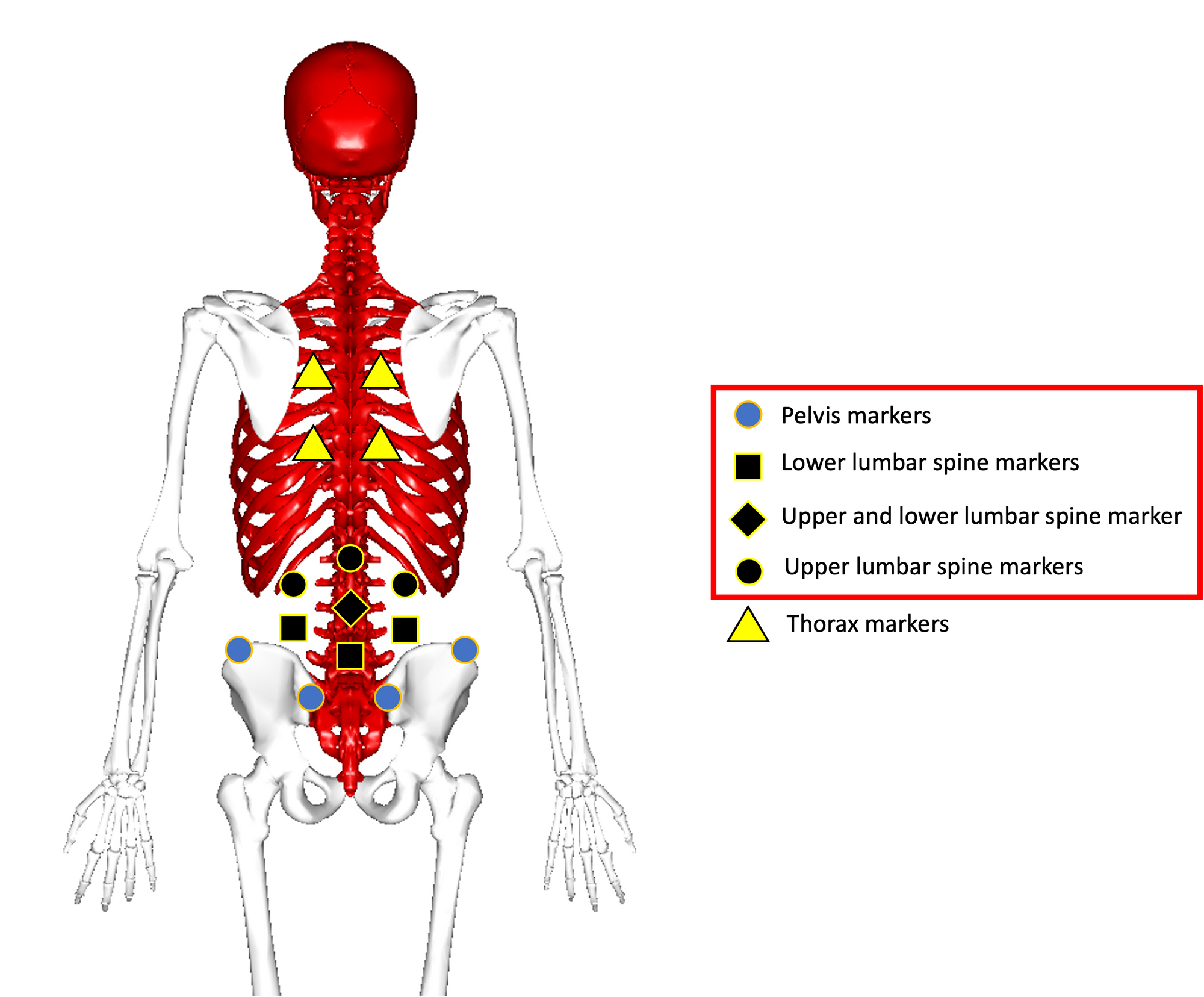Lumbar Spine Motion in people with LBP, living under a rock, fasting, and being persistent - September 28, 2021 Newsletter

📝 Weekly paper summary
Exploring lumbar and lower limb kinematics and kinetics for evidence that lifting technique is associated with LBP (Saraceni et al., 2021)
Category
Case-control
Context
Lower back pain (LBP) is a prevalent ailment that results in many missed days of work. Researchers have attempted to understand how LBP arises to prevent its occurrence, given the costs associated with these ailments. Since there appears to be a link between how the spine moves under load and resulting damage to various structures (e.g., discs, facets), workplaces and gyms have redesigned tasks and how they train workers to lift safely.
One of the main propositions in the literature is that repeated spine flexion and extension under load can damage discs, which may manifest as LBP. However, some researchers have argued that there is no longitudinal or cross-sectional in-vivo evidence that people with LBP flex the lumbar spine more during lifting than those without (Saraceni et al., 2020) (we'll come back to this assertion later 😊).
Therefore, this study aimed to compare the kinematics and kinetics of manual workers with and without LBP. The secondary purpose was to evaluate whether the change in LBP pain intensity was associated with any changes in lifting kinematics or kinetics.
Correctness
Regarding the positives in this investigation, I think they had an excellent sample size, and each individual performed a large number of lifts. Therefore, the researchers appeared to have adequate statistical power to address their questions. Furthermore, I think it was great that they integrated lower extremity kinetics to contextualize their findings.
However, I believe several areas of concern with this paper make it difficult to apply these findings given the research question posed.
First, I think it is worthwhile to illustrate how the researchers quantified lumbar spine angles relative to some of the other methods in the literature (since most of the descriptions for this study are in the supplementary files and not the paper itself):

There are three ways of quantifying spine motion with 3D motion capture systems I'll highlight (2 of which the researchers used in this paper; there are more, but this isn't the appropriate context to do a deep dive either):
- Intra-lumbar angles, which capture the relative orientation between upper lumbar spine segments (L1-L3) relative to the lower lumbar spine segments (L3-L5)
- Lumbo-pelvic angles, which capture the relative orientation between the lower lumbar spine segments (L3-L5) and the pelvis
- Thoracic-pelvic angles, which capture the relative orientation between the thorax and the pelvis
The reason for outlining these different methods is to illustrate that the "angles" reported will be generally larger the further the two segments are from each other. In other words, the angles computed using method 1 < 2 < 3 (i.e., thoracic-pelvic angles provide the largest absolute angles of the three), which is why the lumbar spine angles reported in this study may seem so small in this study.
However, this leads me to one of my first concerns: the lumbar spine angles seem small given what we've seen in other studies that quantified lumbar spine angles using similar methods to assess gymnastics landings (Wade et al., 2012) or running (Seay et al., 2008). I could be misinterpreting what the researchers wrote in their supplementary files, but I think how they decomposed their rotation matrices might explain this discrepancy. Based on what they've reported, it appears that their Y-axis is oriented vertically, their Z-axis is oriented anteroposteriorly, and their X-axis is oriented mediolaterally. Given the ISB recommendations proposed in 2002 by Wu et al. for the spine, I think the researchers may have interchanged their Z and X axes. Therefore, although they used the recommended "Z-X-Y" Euler angle decomposition of the rotation matrix, this would have corresponded to an anteroposterior-mediolateral-vertical sequence of rotations in their study instead of the recommended mediolateral-anteroposterior-vertical sequence of rotations. The consequence of this decision is that the resulting joint angles would be incorrect. Fortunately, PLOS ONE allows us to see the entire peer-review process for this study, but unfortunately, it doesn't appear that the reviewers brought this up. Since the researchers used Vicon Nexus software, I'd tend to trust that the angles are correct since it's a relatively automated pipeline, but this is still a potential red flag.
Second, consider that they measured spine motion when everyone was constrained to lift from the floor (well, not technically, I guess, since the handles were 70mm from the box base). Therefore, it's possible that people performed the lifts similarly because that was the only movement solution available to satisfy such an extreme task constraint. I'm sure the researchers would argue that's partially the point of selecting this task (i.e., they want to intentionally have people perform a task where they would have to flex their spine to see who flexes it less). However, the problem is that we can't delineate whether differences (or, in this case, lack thereof) are attributable to the (extreme) task constraint itself or general behavioural differences between the LBP groups when people performed lifts from only one (extreme) origin height. Therefore, it's not fair, in my opinion, to make sweeping statements that there are no differences between how people with and without LBP flex their spine when lifting, given the lack of generalizability and ecological validity in this study.
Third, based on how they reported it in their methods, their lumbar spine flexion velocity calculation was incorrect (the C-Motion Wiki page has a good write-up explaining how these angles are not vectors, and thus a finite difference technique cannot be used to calculate angular velocity). Therefore, I'm not sure how to contextualize the differences between groups when the data seems incorrect.
Contributions
The authors proposed that the contributions of this research are that it demonstrates there is no in-vivo evidence that lifting with increased spine flexion is associated with LBP. However, I think there are two main issues with this messaging based on the current data (in this study and the total literature):
- They found that those with LBP demonstrated less intra-lumbar flexion and decreased lumbar spine flexion velocity relative to those without LBP. However, it's not clear how to distinguish whether this is a protective mechanism to attenuate symptoms or if it's because there is genuinely no relationship between spine motion while lifting and LBP. This question is likely better addressed with longitudinal data, which brings me to the next point:
- The authors claim there is no in-vivo longitudinal or cross-sectional evidence that lifting with increased spine flexion elevates LBP risk. This assertion is false, and it's surprising how little attention Marras et al.'s 1995 work gets in some of the recent LBP literature. This study is probably the best epidemiological work to date because they measured spine motion in 400+ workers while performing their jobs and didn't infer spine motion based on trunk angles or surveys. Their study wasn't perfect by any means, but, in general, they probably still have the best epidemiological data to date. They reported a pretty strong link between spine lateral velocity, spine twisting velocity, and spine flexion with subsequent injury resulting in lost workdays. Yes, we need to leverage new motion capture technologies and more sophisticated multivariate statistical techniques (since it's clear we need to integrate other psychological and sociological variables into our models) to understand how LBP arises so we can prevent it. However, the premise that no in-vivo data supports that those who flex their spine more (or faster) are at increased risk of lumbar spine disorders is not valid.
Given the previously mentioned limitations and the current state of the literature, it's somewhat difficult to place this study within the rest of the literature (in my opinion).
🧠 Fun fact of the week
Friends and family often accuse me of "living under a rock" since I haven't seen many classic movies (I watched Titanic for the first time about 1.5 years ago now, just to put things in perspective). However, did you know there is a Spanish town, Senetil de las Bodegas, where people actually live under a rock?

The history behind the town and the advantages of living under a rock is fascinating to check out! However, I don't know if it's enough to make me start living under a rock anytime soon 😊.
🎙 Podcast(s) to check out
Dr. Peter Attia does a fantastic job disseminating a variety of health and fitness-related research. I've been consuming a lot of information about fasting and caloric restriction and their impact on health and longevity. Steve Austad does a great job breaking down two of the hallmark studies in the longevity science space. Listening to his backstory was also quite fascinating!
🗣 Quote of the week
"Nothing in this world can take the place of persistence. Talent will not: nothing is more common than unsuccessful men with talent. Genius will not; unrewarded genius is almost a proverb. Education will not: the world is full of educated derelicts. Persistence and determination alone are omnipotent."
- Calvin Coolidge
This quote is just a little extra motivation to get through the nonlinearities of grad school and the challenges of finding our way through life sometimes.
